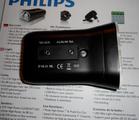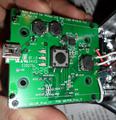

| [ Main index » Bicycle components tests » (Dynamo) bicycle lighting » Philips LED bike light review » Philips LED bike light: Run time test | Dutch: Deze pagina in het Nederlands ] |
The problem described below is under investigation by Philips... Until the results of that investigation are in, it is possible if you buy one, that you will get a lamp that doesn't work correctly. When I get the results I will update this page (as of 2011-8-6 I still haven't heard anything).
Test done with a Philips LBL that has what I think is a production date as printed on the rear of the case, namely 3210 (which I think means week 32 of 2010), and has a mainboard V1.2, dated 29 Apr. 2010.
For all tests I charged the batteries completely, either outside the lamp in the Maha 9000 charger, or with the charger included with the lamp. I tried both methods to see if charging inside the lamp would increase the timer interval from 22 minutes to say 40 minutes in the lamp, i.e. I half expected that the charging in the lamp would give the regulating electronics in the lamp information that says 'enough charge has been put in the batteries'. The batteries were conditioned properly and had about full capacity (about the same as the batteries in the lamp I loaned in August, i.e. about 2250 mAh measured capacity) as checked with my Maha 9000 charger.
My first run time test was with rear of the case off. I put the lamp on high and made notes of what happened:
Test starts at 14:20 h:
14:20 h: Lamp on in high mode. 3 status LEDs on. ca. 22 minutes later: 2 status LEDs on. another ca. 22 minutes later: 1 status LED on. 15:33 h: 0 status LEDs on, or rather, the last one is flashing and the lamp will only operate in eco mode. So up to this point, run time on high is ca. 73 minutes.
I then took out one of the batteries and immediately put it back in again. If there was a timer doing this, it would be reset. And indeed, I could put the lamp in high mode again:
15:34 h: Lamp on (high mode), there are 2 status LEDs on (voltage of the batteries under load: 1.26 V, so very much charge is left in them) ca. 15:54 h: 1 status LED on (batteries are now 1.205V under load). 16:07 h: (batteries are now 1.15V under load). ca. 16:15 h: last status LED flashes, lamp only allows eco mode. So another ca. 41 minutes on high.
I then took out one of the batteries and immediately put it back in again. After switching the lamp on, I could switch to high mode as before. There was a slight delay for this test, I started again a few minutes later:
16:19 h: Lamp on (high mode), there are 2 status LEDs on, voltage under load = 1.15 to 1.17 V for the batteries. 16:27 h: last status LED is flashing, lamp goes into eco mode. 16:36 h: Lamp switches off. So another 8 minutes on high.
Total run time on high is therefore 73 + 41 + 8 = 122 minutes. Note that the low voltage protection cuts off in the last 2 parts as the time between the LEDs going out is less than 22 minutes x no. of LEDs on, so it seems at least in the second part this it does so too soon.
I tried this same test many times, with both open and closed casing, fully charged batteries using Maha 9000 and in other cases the supplied Philips charger was used to charge the batteries in the lamp after first draining them by running the lamp until the batteries were empty.
This means: The lamp switches to eco mode after about 72 minutes, but the batteries are in no way empty, they are almost half full as the test shows. In total I get about the run time of 2 hours on high but I need to take out a battery a few times which seems to reset a timer circuit. So it seems as if the lamp switches off (well, to low mode) with a timer, and doesn't seem to take the battery voltage into account if the battery voltage is high enough. So it doesn't work as it should...
On the rear of the lamp I see a number next to the "don't throw in the bin" sign, and that is 3210. The earlier lamp I loaned from Charles Tsai which had different electronics (it did not automatically switch to eco mode) has a number of 0510. I think these are production date codes, i.e. week 5 of 2010 for the early version, and week 32 of 2010 of the one I bought as a reference/experimenting lamp.
Update 2011-6-15: I got the same behaviour with a lamp with date code 4710. Also, switching the lamp off, then on again doesn't fool the timer, the total runtime will stay at around 1 hour 12 minutes.
Update 2012-1-23: Runtimes of 2 lamps with production dates 0911 and 2111 are ca. 1:25 on high, then taking out a battery and immediately putting it back in again gave another 32 minutes or so on high. Total runtime on high ca. 1:57. This is better than the earlier lamps, but still not 2 hours on high without trickery (taking out a battery and putting it back).
Update 2012-2-15: The 'official' runtime of the LBL has apparently been reduced to 1.5 h, see the main LBL review page.
| To email me go to the email page |
Last modified: Tue Dec 4 00:40:54 CET 2012